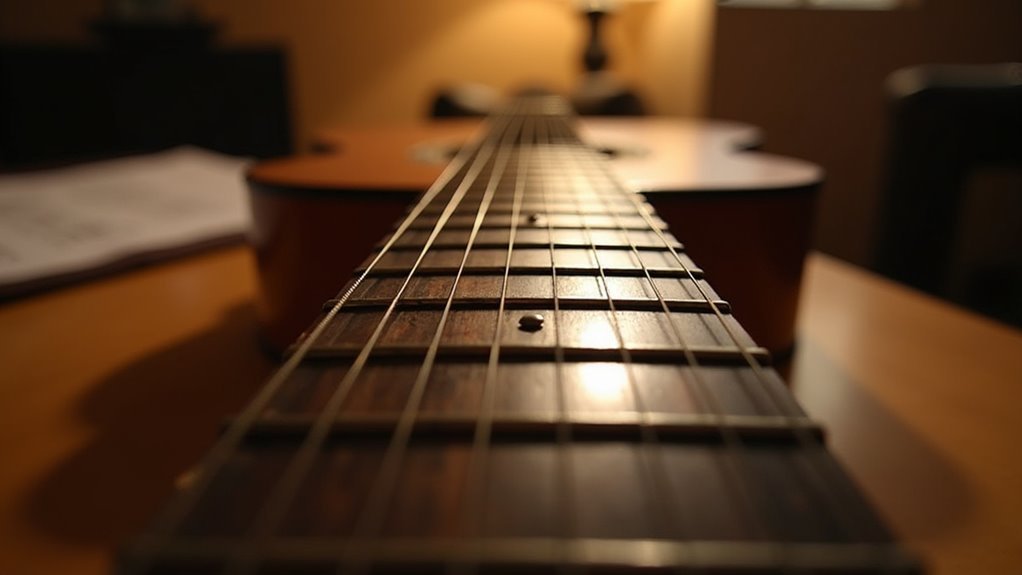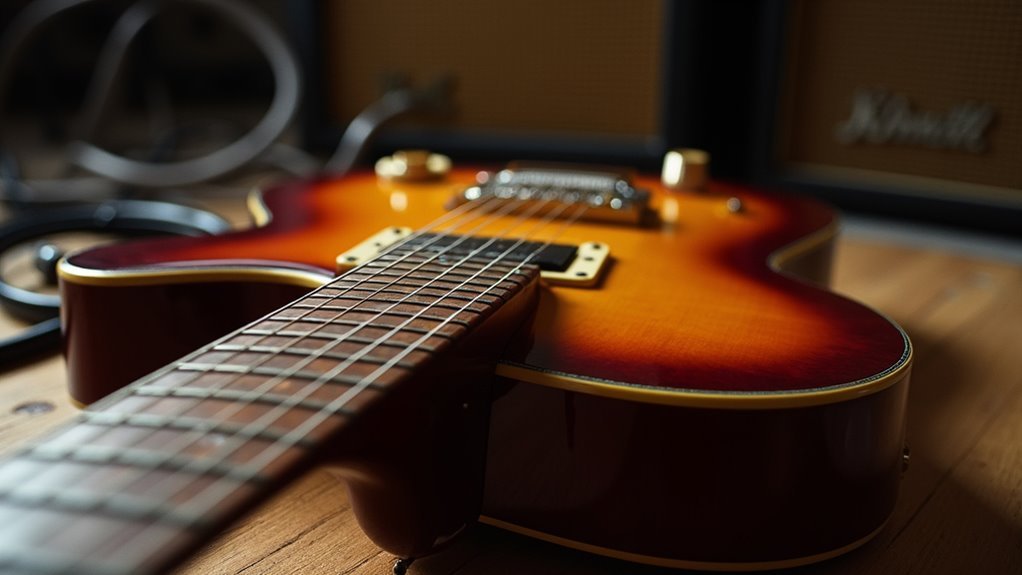Let’s face it – we all know the struggle of staring at those six strings like they’re some alien landscape. But here’s the truth: mastering your fretboard isn’t rocket science. It’s a systematic process that turns confusion into clarity, and we’re going to crack that code together. From the basic musical alphabet to lightning-fast note recognition, we’ll transform that mysterious neck into your playground. The journey starts with understanding one simple concept…
The Musical Alphabet: Your Foundation for Fretboard Mastery

Music’s fundamental building blocks start with a surprisingly simple concept: the musical alphabet. We’re talking about just seven natural notes: A, B, C, D, E, F, and G. That’s it. These notes repeat across your fretboard, creating the foundation for everything you’ll play.
Here’s what makes fretboard memorization click: B and C are neighbors, and so are E and F. The rest follow whole steps. Move up one fret, and you’re climbing the chromatic scale – all twelve notes, including those sharp and flat variations like A#/Bb.
Learning the notes on the guitar isn’t just about memorizing positions; it’s about understanding these relationships. Master this pattern, and you’ll navigate the fretboard like it’s second nature. No shortcuts, no confusion – just pure musical logic.
Navigating the Chromatic Scale on Guitar
Now that you’ve got the musical alphabet down, let’s put it to work with the chromatic scale – your complete roadmap to every note on the guitar.
The chromatic scale is your key to revealing the fretboard’s secrets. Each fret represents one semitone, giving you 12 distinct notes before the pattern repeats. Master this, and you’ll navigate the neck like a pro.
| String | Open Note | 1st Fret |
|---|---|---|
| 6th | E | F |
| 5th | A | A#/Bb |
| 4th | D | D#/Eb |
| 3rd | G | G#/Ab |
| 2nd | B | C |
Start playing the chromatic scale on your low E string. Move up one fret at a time, and you’ll hit every possible note. This systematic approach to learning the fretboard creates a foundation for everything from basic melodies to advanced improvisation.
Essential Note Patterns Across the Fretboard

While memorizing individual notes is essential, recognizing patterns across the fretboard will turbocharge your progress.
Pattern recognition on the fretboard transforms note-by-note learning into quick, intuitive mastery of the entire guitar neck.
Let’s crack the code of note placement by focusing on the musical alphabet‘s natural flow – A through G. Here’s what you need to know: B to C and E to F are next-door neighbors with no sharps between them. That’s your first vital pattern.
Want to learn the fretboard faster? Master octave shapes. Moving up two strings and two frets (or three frets between certain strings) gives you the same note in a higher octave. It’s like a musical GPS.
And remember – we’ve got 12 distinct notes that repeat after the 12th fret. These essential note patterns are your shortcut to confident guitar playing, no calculator needed.
Octave Shapes: Your Roadmap to Complete Neck Knowledge
Let’s unfasten the power of octave shapes – they’re your secret weapon for mastering the fretboard.
To find notes efficiently across your guitar fretboard, we’ll focus on two essential patterns: move up 2 strings and 2 frets from the low E and A strings, or up 2 strings and 3 frets from the D and G strings.
We pair these shapes together because it builds spatial awareness faster. Think of them as your GPS for complete neck knowledge.
By practicing these patterns systematically, you’ll develop rock-solid navigation skills across all positions. Best part? Your improvisation skills will skyrocket as you connect these shapes during solos.
No more getting lost on the neck – just fluid, confident movement between octaves that’ll transform your playing.
Practice Techniques for Rapid Note Recognition

The fastest path to fretboard mastery runs straight through systematic note recognition practice.
We’ll start with the low E and A strings – they’re your foundation for understanding how notes are used across the entire neck.
Let’s tackle this strategically. Learn the natural notes first (A through G), then add those pesky sharps and flats. Grab a fretboard diagram and start drilling root notes daily. Trust us – visual aids work wonders here.
Move from playing to the next level by working through the C Major Scale, naming each note as you play.
The next thing you’ll need? Memory hooks. Create clever phrases that map to note positions – they’ll stick better than raw memorization.
These practice techniques might feel mechanical at first, but they’re your express ticket to fretboard fluency.
Building Speed and Confidence in Fretboard Navigation
Once you’ve got the basics of note locations down, it’s time to kick things into high gear.
Let’s supercharge your fretboard navigation through systematic practice that builds both speed and confidence.
Start by practicing scales with a metronome – it’s non-negotiable for developing rock-solid timing. Connect notes through octave shapes across the neck; you’ll quickly find yourself gliding between positions like they’re second nature.
Set specific goals for each session – master that tricky scale pattern or nail those chord changes.
Here’s the secret sauce: improvisation. We’re not talking about aimless noodling. We mean purposeful exploration that forces your fingers to think fast and move faster.
Combine these approaches, and you’ll develop the finger speed and fretboard fluency that separates the players from the pretenders.
Frequently Asked Questions
How to Memorize All Notes on Fretboard?
Let’s master fretboard mapping through systematic note identification. We’ll combine chord shapes, scale patterns, and musical intervals with daily practice techniques. Visual aids help cement these positions in our memory.
What Is the 3 Fret Rule on Guitar?
Like a roadmap to musical freedom, let’s explore the 3 fret rule: when we play any note, we’ll find its twin three frets higher or one fret up on the next string.
How Long Does It Take to Learn All Notes on Fretboard?
We’ll develop fretboard familiarity in 1-3 months through consistent practice techniques, visual patterns, note association, and ear training, while learning chord relationships and scale knowledge alongside daily exercises.
How Do Guitarists Remember All the Notes?
Let’s picture learning each string separately first. We memorize fretboard patterns through scale practice, visual mapping, and interval training, combining note recognition with mnemonic devices and ear training for mastery.